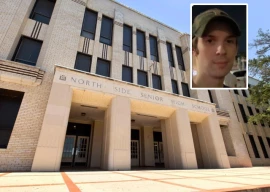
The Pakistani music industry has had its share of legends, but if anyone tops the list of maestros, that has to be Malika-e-Tarannum Noor Jehan — the true melody queen of the subcontinent.
A charity event was held to celebrate the life and music of Noor Jehan on Saturday, April 23, at the Aga Khan University Sports and Rehabilitation Centre.
Conceptualised by veteran musician Arshad Mehmood, the event showcased four distinct phases of the singer’s career.
The evening encapsulated her life as a singing and acting star of the Indian silver screen in the 1930s, as a playback singer for Lollywood from the 1950s to the 1990s, her patriotic and inspirational songs for soldiers during the 1965 and 1971 wars and her soulful renditions of ghazals during the latter half of her career.
To commemorate someone like ‘Madam’ (as she is popularly known in the industry), you really need someone to live up to her melodic renditions and the duo of singers Mehnaz and Humera Channa supported by Mohammad Ali was the best you could get.
More than just a tribute, the event was a recap of the Pakistani film history, revealing unusual facts about the singer such as her work in rendering the vocals for Indian actor Dilip Kumar’s debut film.
The show kicked off with a prayer for Pakistan’s ace comedian Moin Akhtar, who passed away on Friday, April 22. Following a moment of silence, the melodic journey of musical rediscovery began.
The tribute titled Kahan Tak Sunogay featured a short show-reel of Noor Jehan’s works, her life and her contribution to the world of music.
As a part of the first era of her music, the show featured songs from the singer’s vintage collection such as “Tu Konsi Badli Mae Meray Chand Hai Aaja” and the epic “Chandni Raatein” in Mehnaz’s voice. Humera Channa presented her rendition of “Kahan Tak Sunogay”.
The performances were followed by some superhit songs of that era such as the famous lullaby “Chanda Ki Nagri Sae” and “Mehki Fizaain”.
In the 1960s, Pakistani cinema was at its peak when Madam ruled Lollywood . It was the quality of her voice that enabled her to match the mood of any song and the character she was singing for, be it a bedouin woman or a spoilt child from high society.
Classic songs like “Na Chura Sakoge Daman”, “Dil Kay Afsane”, “Lath Uljhi” and “Chalo Acha Hua” were followed by an uplifting duet of “Piya Nahin Aaye” by Channa and Ali.
When we entered the third phase, the older members of the audience seemed more interested in discussing the tracks rather than listening to them. The third era featured the time when Noor Jehan started singing the verses of popular poets and earned more fame for her renditions of poetry by Ahmad Faraz and Faiz Ahmed Faiz.
This era also included her tribute to the Pakistani military forces in the form of “Ae Watan Kay Sajeele Jawano”. At the tribute show, the song was sung by Mehnaz and was thoroughly enjoyed by the audiences. Humera Channa gave her best performance by singing Ahmed Faraz’s “Silsiley Tor Gaya”.
The final phase comprised of Madam’s Punjabi soundtracks, made more interesting with a show-reel. Her Punjabi songs that are still sung at weddings were revived with the renditions of “Sanu Naer Wale Pull Tae”, “Mae Ta Hogai Qurban”, “Sayoni Mera Mahi” and “Teray Mukhre Da Kaala Kaala Til”.
All in all, Kahan Tak Sunogay was an excellent venture and credit is due to Arshad Mehmood, his band and the singers for making it a real tribute.
The event was a part of the fundraising effort by the Aga Khan University Hospital, which provides financial assistance to more than 60,000 patients on campus as well as at its four secondary hospitals.
Published in The Express Tribune, April 27th, 2011.











1737618478-0/Express-Tribune---News-Desk-(9)1737618478-0-270x192.webp)











COMMENTS
Comments are moderated and generally will be posted if they are on-topic and not abusive.
For more information, please see our Comments FAQ